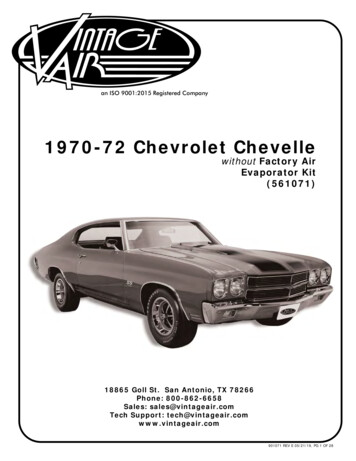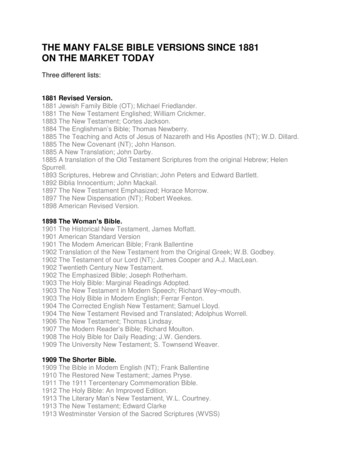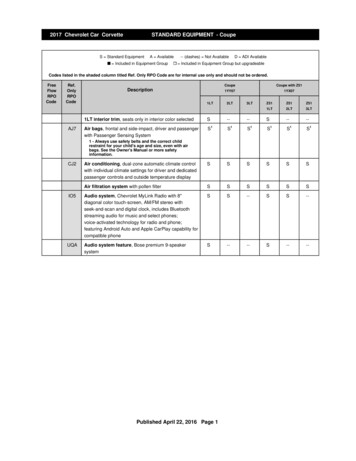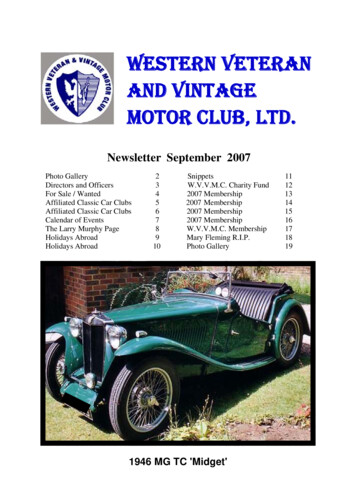
Transcription
an ISO 9001:2015 Registered Company1970-72 Chevrolet Chevellewithout Factory AirEvaporator Kit(561071)18865 Goll St. San Antonio, TX 78266Phone: 800-862-6658Sales: sales@vintageair.comTech Support: tech@vintageair.comwww.vintageair.com901071 REV E 05/21/19, PG 1 OF 28
www.vintageair.comTable of ContentsCover. 1Table of Contents. 2Packing List/Parts Disclaimer. 3Information Page. 4Wiring Notice. 5Engine Compartment Disassembly, Condenser Assembly and Installation,Compressor and Brackets. 6Passenger Compartment Disassembly. 7Kick Panel Modification, Firewall Modification. 8Defrost Duct Installation, (Optional) Hose Adapter Installation (If Equipped). 9Fresh Air Cap & Kick Panel Cover Preparation. 10Fresh Air Cap & Kick Panel Cover Preparation (Cont.), Wiring Installation. 11Wiring Installation (Cont.). 12Kick Panel Cover Installation, Fresh Air Cap Installation. 13Firewall Cover Installation. 14Evaporator Installation. 15Evaporator Installation (Cont.). 16Vehicles without Astro Vents, Vehicles with Astro Vents. 17Drain Hose Installation, Lubricating O-rings, A/C Hose Installation. 18Heater Hose & Heater Control Valve Installation, A/C & Heater Hose Routing. 19Final Steps. 20Control Panel & Duct Hose Routing. 21Wiring Diagram. 22Gen IV Wiring Connection Instruction. 23Operation of Controls. 24Troubleshooting Guide. 25Troubleshooting Guide (Cont.). 26Kick Panel Modification Template. 27Packing List. 282901071 REV E 05/21/19, PG 2 OF 28
Packing List:Evaporator Kit (561071)www.vintageair.comNo.1.2.Qty.11Part No.762169784171DescriptionGen IV Evaporator Sub CaseAccessory Kit** Before beginning installation, open all packages and check contents of shipment.Please report any shortages directly to Vintage Air within 15 days. After 15 days,Vintage Air will not be responsible for missing or damaged items.1Gen IV EvaporatorSub Case7621692HIOFFDASHDEFFLRACCOLDHOTAccessory Kit784171NOTE: Images may not depict actual parts and quantities.Refer to packing list for actual parts and quantities.3901071 REV E 05/21/19, PG 3 OF 28
www.vintageair.comImportant Notice—Please ReadFor Maximum System Performance, Vintage Air Recommends the Following:NOTE: Vintage Air systems are designed to operate with R134a refrigerant only.Use of any other refrigerant could damage your A/C system and/or vehicle, andpossibly cause a fire, in addition to potentially voiding the warranties of the A/Csystem and its components.Refrigerant Capacities:Vintage Air System: 1.8 lbs. (28.8 oz.) or 816 grams of R134a, charged by weight with a quality chargingstation or scale. NOTE: Use of the proper type and amount of refrigerant is critical to systemoperation and performance.Other Systems: Consult manufacturer’s guidelines.Lubricant Capacities:New Vintage Air-supplied Sanden Compressor: No additional oil needed (Compressor is shipped withproper oil charge).All Other Compressors: Consult manufacturer (Some compressors are shipped dry and will need oiladded).Safety SwitchesYour Vintage Air system is equipped with a binary pressure safety switch. A binary switch disengages thecompressor clutch in cases of extreme low pressure conditions (Refrigerant Loss) or excessively high headpressure (406 PSI) to prevent compressor damage or hose rupture. A trinary switch combines Hi/Lopressure protection with an electric fan operation signal at 254 PSI, and should be substituted for use withelectric fans. Compressor safety switches are extremely important since an A/C system relies on refrigerantto circulate lubricant.Service Info:Protect Your Investment: Prior to assembly, it is critical that the compressor, evaporator, A/C hoses andfittings, hardlines, condenser and receiver/drier remained capped. Removing caps prior to assembly willallow moisture, insects and debris into the components, possibly leading to reduced performance and/orpremature failure of your A/C system. This is especially important with the receiver/drier.Additionally, when caps are removed for assembly, BE CAREFUL! Some components are shipped underpressure with dry nitrogen.Evacuate the System for 35-45 Minutes: Ensure that system components (Drier, compressor, evaporatorand condenser) are at a temperature of at least 85 F. On a cool day, the components can be heated with aheat gun or by running the engine with the heater on before evacuating. Leak check and charge tospecifications.Bolts Passing Through Cowl and/or Firewall:To ensure a watertight seal between the passenger compartment and the vehicle exterior, for all boltspassing through the cowl and/or firewall, Vintage Air recommends coating the threads with silicone prior toinstallation.Heater Hose (Not Included With This Kit):Heater hose may be purchased from Vintage Air (Part# 31800-VUD) or your local parts retailer. Routing andrequired length will vary based on installer preference.4901071 REV E 05/21/19, PG 4 OF 28
www.vintageair.comImportant Wiring Notice—Please ReadSome Vehicles May Have Had Some or All of Their Radio Interference Capacitors Removed.There Should Be a Capacitor Found At Each of the Following Locations:1. On the positive terminal of the ignition coil.2. If there is a generator, on the armature terminal of the generator.3. If there is a generator, on the battery terminal of the voltage regulator.Most alternators have a capacitor installed internally to eliminate what is called “whining” asthe engine is revved. If whining is heard in the radio, or just to be extra cautious, a radiointerference capacitor can be added to the battery terminal of the alternator.It is also important that the battery lead is in good shape and that the ground leads are notcompromised. There should be a heavy ground from the battery to the engine block, andadditional grounds to the body and chassis.If these precautions are not observed, it is possible for voltage spikes to be present on thebattery leads. These spikes come from ignition systems, charging systems, and fromswitching some of the vehicle’s other systems on and off. Modern computer-operatedequipment can be sensitive to voltage spikes on the power leads, which can cause unexpectedresets, strange behavior, and/or permanent damage.Vintage Air strives to harden our products against these types of electrical noise, but there isa point where a vehicle’s electrical system can be degraded so much that nothing can help.Radio interference capacitors should be available at most auto and truck parts suppliers. Theytypically are cylindrical in shape, a little over an inch long, a little over a half inch in diameter,and they have a single lead coming from one end of the cylinder with a terminal on the end ofthe wire, as well as a mounting clip which is screwed into a good ground on the vehicle. Thespecific value of the capacitance is not too significant in comparison to ignition capacitors thatare matched with the coil to reduce pitting of the points. Care must be taken, when installing the compressor lead, not to short it to ground.The compressor lead must not be connected to a condenser fan or to any otherauxiliary device. Shorting to ground or connecting to a condenser fan or any otherauxiliary device may damage wiring, the compressor relay, and/or cause amalfunction. When installing ground leads on Gen IV systems, the blower control ground and ECUground must be connected directly to the negative battery post. For proper system operation, the heater control valve must be connected to theECU.5901071 REV E 05/21/19, PG 5 OF 28
www.vintageair.comEngine Compartment DisassemblyNOTE: Before starting the installation, check the function of the vehicle (horn, lights, etc.) for properoperation, and study the instructions, illustrations, & diagrams.Perform the Following:1. Disconnect battery.2. Remove battery and battery tray (retain).3. Drain radiator.4. Remove OEM heater hoses (discard).5. Remove OEM blower assembly (discard). NOTE: To remove the blower assembly (under hood) and theair distribution system (under dash), the factory manual recommends removing the passengerside inner fender.6. Remove OEM heater wiring/vacuum harness molded grommet (See Figure 1, below).Heater HoseClampOEMBlower MotorAssemblyInner FenderPanelFigure 1Condenser Assembly and Installation1. Refer to separate instructions included with the condenser kit to install the condenser.2. Binary switch installation (Refer to condenser instructions).Compressor and Brackets1. Refer to separate instructions included with the bracket kit to install the compressor bracket.6901071 REV E 05/21/19, PG 6 OF 28
Passenger CompartmentDisassemblywww.vintageair.comNOTE: Removal of dashboard is required to install the evaporator. Vintage Air recommends using thefactory service manual when disassembling and reassembling the dashboard.Perform the Following:1. Remove the dash pad by removing (6) OEM screws (retain) (See Figure 1, below).2. Lower the steering column. Protect the steering column with a cloth.3. Disconnect all wires and cables from the instrument panel, speedometer, control panel and radio.4. Remove the lower dash by removing the (8) OEM bolts (retain).5. Remove all hoses and ducting from the OEM louvers and astro vent door (if equipped) (See Figure 1, below).6. Remove OEM defrost duct assembly by removing (4) screws (See Figure 2, below).7. Remove OEM heater assembly (discard) (See Figure 2, below).8. Remove passenger side kick panel/fresh air door assembly as shown in Figure 1, Page 8.DashPadDoorFlap(6) OEMScrewsControlPanelFigure 1InstrumentPanelHeater Assembly& Related DuctingDefrost DuctAssemblyFigure 27OEM HeaterAssembly901071 REV E 05/21/19, PG 7 OF 28
Kick Panel Modificationwww.vintageair.com1. Remove kick panel grille (discard). Remove the kick panel by removing (5) OEM screws from the fresh air doorassembly. Disconnect and discard the pull cable assemblies from the kick panel (See Figure 1, below).2. Install 1/2” plastic plugs to fill the holes left from the removal of the pull cable assembly (See Figure 2, below).3. Locate the template provided on Page 28. Place template on kick panel as shown in Figure 2a, below.4. Cut the fresh air door assembly as shown in Figure 2a, below.5. Reinstall the kick panel.OEMScrewsFresh AirDoor AssemblyPull CableAssembliesKick PanelGrilleFigure 1TemplateFigure 2a1/2” PlasticPlugCutOutkOutl C tene plaPa emTllevehe2 C A/C-768 ithoutwutFresh Air DoorAssemblyKicCut OutThis Section19Figure 2Firewall ModificationNOTE: Firewall modification is required for firewall cover and drain hose installation.1. Flatten the edges of the firewall opening (See Photo 1, below).Flatten FirewallOpening EdgesEngineCompartment Side8Photo 1901071 REV E 05/21/19, PG 8 OF 28
Defrost Duct Installationwww.vintageair.com1. Install the defrost ducts under the dash, and secure using OEM screws as shown in Figure 1, below.2. If the vehicle is equipped with astro vents, install the astro vent caps as shown in Figure 1, below.OEMDefrost DuctMounting FlangeOEMAstro Vent(If Equipped)DefrostDuct626670OEMScrewsAstro VentCap498825OEMAstro Vent(If Equipped)Astro VentCap498825Figure 1Hose Adapter Installation (If Equipped)1. Install (3) S-clips onto hose adapters as shown in Figure 1, below.2. Install the driver & passenger side hose adapters inside the OEM louvers (See Figure 1, below).Driver SideLouver HoseAdapter498823Passenger SideLouver HoseAdapter498824(3) S-clips(3) S-clipsDriver SidePassenger SideFigure 19901071 REV E 05/21/19, PG 9 OF 28
Fresh Air Cap &Kick Panel Cover Preparationwww.vintageair.com1. Install (4) large grommets and a 7/8” grommet into the fresh air cap (See Photos 1 & 2, below).2. On the inside of the fresh air cap, the letter “T” indicates the top mounting hole for the firewall (See Photo 3,below).3. From the center of the bottom left hole in the kick panel cover, measure 1 ½” down. Mark and drill a 5/8” holefor the 7/8” grommet (See Photos 4 & 5, below).7/8” Grommet33144-VUI(4) LargeGrommets33137-VUIFresh Air Cap622230Photo 1Photo 2“T” IndicatesTop Mounting HolePhoto 3Kick Panel Cap6266671 ½”Drill 5/8” HolePhoto 5Photo 410901071 REV E 05/21/19, PG 10 OF 28
www.vintageair.comFresh Air Cap &Kick Panel Cover Preparation (Cont.)4. Install (4) large grommets and a 7/8” grommet into the kick panel cover (See Photos 6 & 7, below).(4) LargeGrommets33137-VUI7/8” Grommet33144-VUIPhoto 6Photo 7Wiring Installation1. From the passenger compartment, route the heater control valve connector and wiring (red, whiteand green) through the 7/8” grommet in the kick panel cover (See Figure 1, below). NOTE: Leaveapproximately 1” of wiring between the kick panel cover and the harness connector. This allowsenough wiring to reach the harness.2. Disconnect the circuit breaker from the main wiring harness (See Photo 1, below).7/8” Grommet33144-VUIKick Panel Cover626667CircuitBreakerApproximately 1”Heater ControlValve Connector andWiring (Red, White andGreen)Photo 1Figure 111901071 REV E 05/21/19, PG 11 OF 28
Wiring Installation (Cont.)www.vintageair.com3. Route the red, white and blue wires from the main wiring harness through the 7/8” grommet in the kick panelcover (See Photo 2, below). NOTE: Leave approximately 5” of wiring between the relay and the kickpanel cover. This allows enough wiring to secure the relay to the mounting position.4. Route the heater control valve wiring (red, white and green) through the 7/8” grommet in the fresh air cap(See Photo 3, below).5. Route the main harness wiring (red, white and blue) through the 7/8” grommet in the fresh air cap (SeePhoto 4, below).Kick Panel Cover626667Main WiringHarness(Red, Whiteand Blue)Photo 2Approximately 5”7/8” Grommet33144-VUIFresh Air Cap622230Main WiringHarness(Red, Whiteand Blue)Heater ControlValve Connectorand Wiring (Red,White and Green)Photo 3Photo 412901071 REV E 05/21/19, PG 12 OF 28
Kick Panel Cover Installationwww.vintageair.com1. Route the A/C and heater hoses through the kick panel cover as shown in Figure 1, below.2. Apply 1/4” bead of silicone around the back side of the kick panel cover as shown in Figure 1, below.3. Secure the kick panel cover using (5) #8 x 1 ¼” screws as shown in Figure 1, below.SiliconeMating Surface ofKick Panel Cover(5) #8 x 1 ¼”Screws#6 A/C Hose(2) Heater HoseFigure 1#10 A/C HoseFresh Air Cap InstallationNOTE: The fresh air cap installs on the engine side of the firewall.1. Route the A/C and heater hoses through the fresh air cap as shown in Figure 1, below.2. Gently pull the slack from the hoses in the passenger compartment, making sure the hoses are not kinked.3. Slide the fresh air cap into position, and secure it to the firewall using (2) #14 x 3/4” sheet metal screws (SeePhoto 1, below).4. Apply silicone around the outer edge of the fresh air cap (See Photo 1, below).Apply SiliconeAround FreshAir Cap#6 A/C HoseSecure Fresh Air Capwith (2) #14 x 3/4”Sheet Metal Screws#10 A/C Hose(2) Heater HoseFigure 1Photo 113901071 REV E 05/21/19, PG 13 OF 28
Firewall Cover Installationwww.vintageair.comNOTE: For proper system operation, Vintage Air recommends using heat blocking insulation inthe area around the evaporator unit (firewall, kick panel, inner cowl and firewall covers). Due totight clearance for the evaporator unit, between the firewall and dash, Vintage Air recommends aninsulation thickness of no more than 1/4”.1. Install (3) 1/4-20 x 3/4” bolts with pushnut bolt retainers onto the firewall cover (See Photo 1, below).2. From the engine side compartment, temporarily install the firewall cover onto the firewall (See Photo 2,below).3. From the passenger compartment, trace around the firewall opening onto the firewall cover (See Photo 3,below).4. Remove the firewall cover and apply insulation to the traced area (See Photos 4 & 5, below).5. Apply silicone to the mating surface of the firewall cover (See Figure 1, below).6. Install the firewall cover onto the firewall, and secure it using (3) 5/8” washers and (3) 1/4-20 nuts with starwashers (See Photo 6, below).7. Clean the firewall and necessary areas, and then apply heat blocking insulation.Trace AroundFirewall OpeningFirewall CoverFirewall Cover(3) 1/4-20 x 3/4” Boltswith Pushnut Bolt RetainerPhoto 1Engine CompartmentViewPhoto 2PassengerCompartmentViewSiliconeInsulationApply Insulationto Traced AreaPhoto 4Photo 5Photo 3Back Sideof FirewallCoverFigure 1Install (3) 5/8” Washers and(3) 1/4-20 Nuts with Star WashersPhoto 614901071 REV E 05/21/19, PG 14 OF 28
Evaporator Installationwww.vintageair.com1. On a workbench, install (2) heater fittings with properly lubricated O-rings (See Lubricating O-rings, Page 18and Photo 1, below).2. Install the evaporator front & rear brackets onto the evaporator, and secure them using (5) 1/4-20 x 1/2”serrated hex cap screws as shown in Photos 2 and 3, below.3. Install (2) 1/4-20 x 1 ½” studs onto the evaporator rear bracket as shown in Photo 4, below.4. Lay the evaporator sub case on the passenger side floorboard. Install the A/C & heater hoses on theevaporator as shown in Figure 1, Page 16, and A/C hose installation instructions on Page 18. NOTE: Wrapthe #10 fitting connections with press tape (See Figure 1, Page 16).Evaporator Unit(2) HeaterFittings1/4-20 x 1/2”Serrated Hex Cap ScrewEvaporator FrontBracket647066Photo 11/4-20 x 1/2”Serrated Hex Cap ScrewPhoto 2Evaporator RearBracket655002(2) 1/4-20 x 1 ½”StudsPhoto 3Evaporator RearBracket65500215Photo 4901071 REV E 05/21/19, PG 15 OF 28
Evaporator Installation (Cont.)www.vintageair.comNOTE: To ensure a watertight seal between the passenger compartment and the vehicle exterior, forall bolts passing through the firewall, Vintage Air recommends coating the threads with silicone priorto installation.1. Lift evaporator unit up under the dashboard. Secure loosely to the firewall from the engine compartment sideusing (2) 1/4-20 nuts and flat washers (See Figure 2, below). NOTE: To ensure proper drainage, it isvery important that the evaporator is level, both left-right and fore-aft. Check for level on the flatportions of the case around the drain.2. Using the OEM screw, secure the evaporator front bracket between the dash bracket and cowl bracket (SeeFigure 2a, below).3. Verify that evaporator unit is level and square to the dash; then tighten all mounting bolts. NOTE: Replacethe (2) 1/4-20 x 1 ½” studs with (2) 1/4-20 x 3/4” bolts and peFigure 2a#6 A/CHoseHeaterHosesHoseClamps#10 A/CHoseFigure 1Kick PanelCover(2) 1/4-20Nuts andFlat WashersNOTE: Coat bolt threads withsilicone before installing nutsand washers.Figure 216901071 REV E 05/21/19, PG 16 OF 28
www.vintageair.com1. Install the louver housings under the dash as shown in Figure 1, below.2. Install louvers into the housings as shown in Figure 1, below.Figure 1(6) #8 x 1/2”Pan HeadScrewsVehicles with Astro Vents1. Install the center louver under the dash as shown in Figure 1, below.2. For astro vent hose adapter installation, refer to Page 9.(2) #8 x 1/2”Pan HeadScrews17Figure 1901071 REV E 05/21/19, PG 17 OF 28
Drain Hose Installationwww.vintageair.com1. Locate the evaporator drain on the bottom of the evaporator case.2. In line with the drain, lightly make a mark on the firewall. Measure 1” down and 2 ½” to the left. Drill a 5/8”hole through the firewall (See Figure 1, below).3. Install the drain hose to the outlet on the bottom of the evaporator unit, and route it through the firewall (SeeFigure 1, below).2 ½”1”EvaporatorCase1”2 ½”DrainHoseFigure 1Lubricating O-ringsMaleO-ring InsertFemale Nut#6 O-ring#8 O-ring#10 O-ringFor a proper seal of fittings: Install suppliedO-rings as shown, and lubricate with suppliedoil.O-ringSupplied Oilfor O-ringsNOTE: Standard torque specifications:#6: 11 to 13 ft-lb.#8: 15 to 20 ft-lb.#10: 21 to 27 ft-lb.O-ring InstallsOver Male Insertto Swaged LipFigure ##Twist WithThis WrenchHold WithThis WrenchA/C Hose InstallationStandard Hose Kit:1. Locate the #8 compressor A/C hose. Lubricate (2) #8 O-rings (See Lubricating O-rings, above) and connectthe 135 fitting with service port to the #8 discharge port on the compressor. Then route the straight fitting tothe #8 condenser hardline coming through the core support (See Figure 1, Page 19, and Figure 1, Page 20).Tighten each fitting connection as shown in Lubricating O-rings, above.2. Locate the #10 compressor A/C hose. Lubricate (2) #10 O-rings (See Lubricating O-rings, above) and connectthe #10 135 fitting with service port to the #10 suction port on the compressor. Then route the 90 fitting tothe #10 fitting on the evaporator (See Figure 1, Page 16, Figure 1, Page 19, and Figure 1, Page 20). Tighteneach fitting connection as shown in Lubricating O-rings, above.3. Locate the #6 evaporator A/C hose. Lubricate (2) #6 O-rings (See Lubricating O-rings, above) and connectthe straight fitting to the #6 hardline coming through the core support from the drier. Then route the 90 fitting to the #6 fitting on the evaporator (See Figure 1, Page 16, Figure 1, Page 29, and Figure 1, Page 20).Tighten each fitting connection as shown in Lubricating O-rings, above.4. Using a #10 Adel clamp and a 10-32 x 1/2” pan head screw with a nut, secure the #10 A/C hose to thealternator bracket as shown in Figure 1, Page 19.Modified Hose Kit:1. Refer to separate instructions included with modified hose kit.18901071 REV E 05/21/19, PG 18 OF 28
19FROMTO EVAPOWATER RATOPUM RPHoseClampsNOTE: Flow direction followsmolded arrow on valve.HeaterHoseFrom HeaterControl Valveto Evaporator#10 A/CHose096073#6 HardlineDrier/Condenser35368-VCG#6 Drier/Core Hardline091173#6 A/C Hose096072Figure 1FROMMA INTAKNIFOLD EHeater Hose(Heater ControlValve/Intake)Tie Wrap#10 AdelClamp with10-32 x 1/2”Pan HeadScrewwith NutCompressorSafety Switch(Binary Type)Screw-on Drier(Refer toCondenserInstructions)#8 Condenser/CompressorHardline091172#8 CondenserHardline09169-FFD#8 A/CHose096062NOTE: Vintage Air Systems use 5/8” heater connections. On engines equipped with 3/4” hosenipples, these will need to be removed and replaced with 5/8” nipples (not supplied). For waterpumps with a cast-in 3/4” heater outlet, a 3/4” x 5/8” reducer fitting in the heater hose (notsupplied) or molded hose (Vintage Air Part # 099010) will need to be installed.A/C & Heater Hose Routingwww.vintageair.comHeater Hose& Heater Control Valve Installation1. Route a piece of heater hose from the water pump to the top heater fitting of the heater core as shown inFigure 1, Page 16, and Figure 1, below. Secure using hose clamps.2. Route a piece of heater hose from the intake to the bottom heater fitting of the heater core as shown inFigure 1, Page 16, and Figure 1, below. NOTE: Install heater control valve in line with intake manifold(pressure side) heater hose. Secure using hose clamps as shown in Figure 1, below. Also noteproper flow direction.901071 REV E 05/21/19, PG 19 OF 28
Final Stepswww.vintageair.com1. Install duct hoses as shown in Figure 1, Page 21.2. Install the control panel assembly. Refer to the control panel instructions.3. Plug the wiring harnesses into the ECU module on the sub case as shown in Figure 1, Page 21. Wire accordingto the wiring diagrams on Pages 22 and 23.4. Modify the glove box as shown in Figure 2, below.5. Install (4) S-clips onto the glove box cap, and install it onto the glove box as shown in Figure 3, below.6. Reinstall all previously removed items (battery tray, battery, and inner fender).7. Fill radiator with at least a 50/50 mixture of approved antifreeze and distilled water. It is the owner’sresponsibility to keep the freeze protection at the proper level for the climate in which the vehicle is operated.Failure to follow antifreeze recommendations will cause heater core to corrode prematurely and possibly burstin A/C mode and/or freezing weather, voiding your warranty.8. Double check all fittings, brackets and belts for tightness.9. Vintage Air recommends that all A/C systems be serviced by a licensed automotive A/C technician.10. Evacuate the system for a minimum of 45 minutes prior to charging, and perform a leak check prior toservicing.11. Charge the system to the capacities stated on Page 4 of this instruction manual.12. See Operation of Controls procedures on Page 24.Cut Off 2”(Discard)#6 A/CHose#10 A/CHoseTop ofGloveBox2”Figure 1(2) HeaterHoses(4) S-clipsFigure 2Glove BoxCap626670Figure 320901071 REV E 05/21/19, PG 20 OF 28
www.vintageair.comControl Panel & Duct Hose RoutingBack Sideof PC BoardAssemblyControl PanelHarnessFrom ECU232007-VURPassenger SideDefrost Duct2” x 12”Under DashCenter Louver2” x 20”Driver SideDefrost Duct2” x 18”Driver SideLouver2 ½” x 32”Plug FromWiring Harness232600-VUAFigure 121Passenger SideLouver2 ½” x 36”901071 REV E 05/21/19, PG 21 OF 28
Wiring REDWHT/REDWHT/YELWHT/GRNAC ANNUNCIATORBACKLIGHT POSBACKLIGHT NEGGND5V-SWTEMP WIPERMODE WIPERFAN WIPERPRE-WIREDVIEWED FROM WIRE SIDE232002-VUAA/C(IF USED)GEN IV ECUGEN IV WIRING DIAGRAMREV E, 10/6/2017TEMPMODEFANPROGRAM* DASH LAMP(IF USED)*** WIDE OPENTHROTTLESWITCH(OPTIONAL)** CIRCUITBREAKER30 AMPHEATERCONTROL VALVE* Dash Lamp Is Used Only With Type 232007-VUR Harness.** Warning: Always Mount Circuit Breaker As Close to the Battery As Possible. (NOTE: Wire BetweenBattery and Circuit Breaker Is Unprotected and Should Be Carefully Routed to Avoid a ShortCircuit).*** Wide Open Throttle Switch Contacts Close Only at Full Throttle, Which Disables A/CCompressor.22901071 REV E 05/21/19, PG 22 OF 28
Gen IV WiringConnection :MOUNT RELAYIN DESIREDLOCATIONUNDER DASHREDWHITEIgnition Switch:VIOLETViolet 12V Ign Switch Source (Key OnAccessory) Position Must Be Switched. 12VNOTE:WIRING YELLOW & ORANGE (IGNITION HOTHARNESS COMING FROMTERMINAL)HARNESS ARE NOTUSED.YELLOWRUNBATIGNITIONSWITCHORANGETANDASH BACK LIGHT 0-12vGRAYGRAY WIRE IS USED FORPROGRAMING CONTROLSIF APPLICABLEREDGREENREDGREENFIREWALLBLACK BLUEHeater Control Valve:REDLATCHWIRINGHARNESSWHITECHASSIS GROUNDNOTE: HEATER CONTROLVALVE CONNECTION ANDCHASSIS GROUND MAY BELOCATED ON EITHER SIDEOF THE FIREWALL. ENSURECONNECTOR IS LATCHEDFIRMLY.HEATERCONTROL VALVEKBLACBLUECOMPRESSORWHITENOTE: CONNECT WHITEWIRES DIRECTLY TO(-) BATTERY TERMINALWHITEREDREDCIRCUIT BREAKER30 AMPInstall With Servo Motor Facing Down,As Shown. Note Flow Direction ArrowMolded Into Valve Body, And InstallAccordingly.Binary/Trinary & Compressor:Binary: Connect As Shown (TypicalCompressor Wiring). Be SureCompressor Body Is Grounded.BINARYSAFETYSWITCHBLUEDash Light:Tan Wire Used Only With Vintage AirSupplied Control Panel With LED BackLight.Circuit Breaker/Battery:White Must Run To (-) Battery. Red MayRun To ( ) Battery Or Starter. MountCircuit Breaker As Close to Battery AsPossible.REDWARNING:ALWAYS MOUNT CIRCUIT BREAKERAS CLOSE TO THE BATTERY AS POSSIBLE.(NOTE: WIRE BETWEEN BATTERY ANDCIRCUIT BREAKER IS UNPROTECTEDAND SHOULD BE CAREFULLY ROUTEDTO AVOID A SHORT CIRCUIT). Trinary Switch: Connect According ToTrinary Switch Wiring Diagram.-BATTERY23901071 REV E 05/21/19, PG 23 OF 28
Operation of Controlswww.vintageair.comOn Gen IV systems with three lever/knob controls, the temperature control toggles between heat and A/Coperations. To activate A/C, move the temperature lever/knob all the way to cold and then back it off to the desiredvent temperature. For heat operation, move the temperature lever/knob all the way to hot and then adjust to thedesired vent temperat
without Factory Air Evaporator Kit (561071) 901071 REV E 05/21/19, PG 1 OF 28 18865 Goll St. San Antonio, TX 78266 Phone: 800-862-6658 Sales: sales@vintageair.com Tech Support: tech@vintageair.com www.vintageair.com. 2 www.vintageair.com 901071 REV E 05/21/19, PG 2 OF 28 Table of Contents










